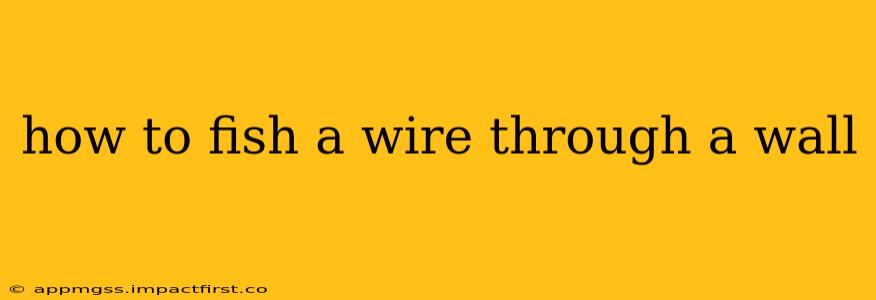Running wires through walls can seem daunting, but with the right tools and techniques, it's a manageable DIY project. This guide will walk you through various methods, helping you choose the best approach for your specific situation and ensuring a clean, efficient installation. Whether you're adding a new outlet, installing network cabling, or running wires for a home theater system, this guide will equip you with the knowledge you need.
What Tools Do I Need to Fish a Wire Through a Wall?
Before you begin, gather the necessary tools. The exact tools will depend on your chosen method, but here's a general list:
- Fish Tape: This flexible metal tape is essential for navigating tight spaces. Different lengths and thicknesses are available.
- Wire Snake: Similar to fish tape, but often more flexible and better for navigating complex pathways.
- Stud Finder: Crucial for locating wall studs to avoid damaging them.
- Drill with appropriate drill bits: For creating access holes.
- Safety Glasses: Protect your eyes from debris.
- Work Gloves: Protect your hands.
- Optional: Vacuum Cleaner: To clean up any debris created during the process.
- Optional: Endoscope/Camera: Useful for navigating particularly challenging spaces or checking wire placement.
How to Find the Path for Your Wire: Planning is Key
The success of this project hinges on planning. Before you even touch a tool, determine the optimal path for your wire:
- Identify the starting and ending points: Know exactly where your wire needs to enter and exit.
- Locate wall studs and electrical wiring: Use a stud finder and an electrical wire detector to avoid damaging structural components or existing wiring. This is a crucial safety step!
- Consider existing pathways: Are there any existing holes or conduits you can utilize? This can significantly simplify the process.
- Sketch your plan: A simple diagram will help you visualize the route and anticipate any potential obstacles.
Different Methods for Fishing a Wire Through a Wall
There are several methods you can use to fish a wire through a wall, each with its advantages and disadvantages:
Using a Fish Tape or Wire Snake
This is the most common method. Insert the fish tape or wire snake into your starting hole and carefully guide it to the desired exit point. Attach your wire to the end of the tape/snake and pull it through.
- Tip: Use lubrication (like powdered graphite) on the fish tape to help it glide more smoothly.
Accessing Through Existing Outlets or Junction Boxes
If you're adding a new outlet near an existing one, this can be the easiest method. Remove the faceplate and carefully loosen the wires in the junction box. You might be able to carefully push or pull the new wire through the existing pathways.
Drilling Access Holes Strategically
If existing pathways are unavailable, you might need to drill access holes along your planned route. This requires careful planning to avoid studs and electrical wiring. Use small-diameter holes to minimize damage.
Using a Handheld Vacuum to Pull Wire
If you have a vacuum with a narrow hose attachment, you may be able to use the suction to pull the wire through. Attach the wire to a weight or sturdy object and suck it through.
What if I Can't Get the Wire Through?
Sometimes, even with careful planning, fishing a wire can be tricky. Here are some troubleshooting tips:
- Try a different method: If one method isn't working, try another.
- Use a stronger fish tape or wire snake: A thicker, stiffer tape might be better for pushing through tougher obstacles.
- Use a helper: Having someone at the other end to guide or pull the tape/snake can be beneficial.
- Consider additional access holes: If the path is too convoluted, creating another access point might be necessary.
How Do I Protect the Wire After Fishing?
Once the wire is in place, secure it properly to prevent damage. If possible, use staples, cable ties, or conduit to keep it away from sharp edges and other potential hazards.
What Happens if I Hit a Stud or Electrical Wiring?
Stop immediately! Contact a qualified electrician to safely complete the wiring. Attempting to proceed could result in injury or damage to your home's electrical system.
This comprehensive guide should help you successfully fish a wire through a wall. Remember to prioritize safety and proper planning for a successful outcome. Remember, if you're uncomfortable with any part of this process, it's always best to consult a qualified electrician.
